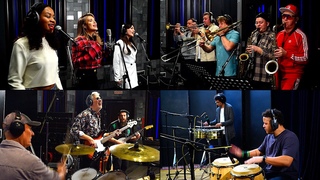Transcription and Translation: DNA to mRNA to Protein
The genes in DNA encode protein molecules, which are the “workhorses“ of the cell, carrying out all the functions necessary for life. For example, enzymes, including those that metabolize nutrients and synthesize new cellular constituents, as well as DNA polymerases and other enzymes that make copies of DNA during cell division, are all proteins.
In the simplest sense, expressing a gene means manufacturing its corresponding protein, and this multilayered process has two major steps. In the first step, the information in DNA is transferred to a messenger RNA (mRNA) molecule by way of a process called transcription. During transcription, the DNA of a gene serves as a template for complementary base-pairing, and an enzyme called RNA polymerase II catalyzes the formation of a pre-mRNA molecule, which is then processed to form mature mRNA. The resulting mRNA is a single-stranded copy of the gene, which next must be translated into a protein molecule.
During translation, which is the second major step in gene expression, the mRNA is “read“ according to the genetic code, which relates the DNA sequence to the amino acid sequence in proteins. Each group of three bases in mRNA constitutes a codon, and each codon specifies a particular amino acid (hence, it is a triplet code). The mRNA sequence is thus used as a template to assemble—in order—the chain of amino acids that form a protein.
But where does translation take place within a cell? What individual substeps are a part of this process? And does translation differ between prokaryotes and eukaryotes? The answers to questions such as these reveal a great deal about the essential similarities between all species.
Where Translation Occurs
Within all cells, the translation machinery resides within a specialized organelle called the ribosome. In eukaryotes, mature mRNA molecules must leave the nucleus and travel to the cytoplasm, where the ribosomes are located. On the other hand, in prokaryotic organisms, ribosomes can attach to mRNA while it is still being transcribed. In this situation, translation begins at the 5’ end of the mRNA while the 3’ end is still attached to DNA.
In all types of cells, the ribosome is composed of two subunits: the large (50S) subunit and the small (30S) subunit (S, for svedberg unit, is a measure of sedimentation velocity and, therefore, mass). Each subunit exists separately in the cytoplasm, but the two join together on the mRNA molecule. The ribosomal subunits contain proteins and specialized RNA molecules—specifically, ribosomal RNA (rRNA) and transfer RNA (tRNA). The tRNA molecules are adaptor molecules—they have one end that can read the triplet code in the mRNA through complementary base-pairing, and another end that attaches to a specific amino acid (Chapeville et al., 1962; Grunberger et al., 1969). The idea that tRNA was an adaptor molecule was first proposed by Francis Crick, co-discoverer of DNA structure, who did much of the key work in deciphering the genetic code (Crick, 1958).
Within the ribosome, the mRNA and aminoacyl-tRNA complexes are held together closely, which facilitates base-pairing. The rRNA catalyzes the attachment of each new amino acid to the growing chain.
The Beginning of mRNA Is Not Translated
Interestingly, not all regions of an mRNA molecule correspond to particular amino acids. In particular, there is an area near the 5’ end of the molecule that is known as the untranslated region (UTR) or leader sequence. This portion of mRNA is located between the first nucleotide that is transcribed and the start codon (AUG) of the coding region, and it does not affect the sequence of amino acids in a protein (Figure 3).
So, what is the purpose of the UTR? It turns out that the leader sequence is important because it contains a ribosome-binding site. In bacteria, this site is known as the Shine-Dalgarno box (AGGAGG), after scientists John Shine and Lynn Dalgarno, who first characterized it. A similar site in vertebrates was characterized by Marilyn Kozak and is thus known as the Kozak box. In bacterial mRNA, the 5’ UTR is normally short; in human mRNA, the median length of the 5’ UTR is about 170 nucleotides. If the leader is long, it may contain regulatory sequences, including binding sites for proteins, that can affect the stability of the mRNA or the efficiency of its translation.
Translation Begins After the Assembly of a Complex Structure
The translation of mRNA begins with the formation of a complex on the mRNA (Figure 4). First, three initiation factor proteins (known as IF1, IF2, and IF3) bind to the small subunit of the ribosome. This preinitiation complex and a methionine-carrying tRNA then bind to the mRNA, near the AUG start codon, forming the initiation complex.
#DNA #mRNA #tRNA #translation #transcription #polypeptide #aminoAcid #NikolaysGeneticsLessons #protein #peptide #disulfideBridges #covalentBounding #ionicBounding #hydrophobicInteraction #proteinStructure #proteinSequence #proteinFolding #ami











![[MV] DAY6(데이식스) _ Chocolate (Want More 19(하지 말라면 더 하고 19) OST Part.1)](https://sun9-71.userapi.com/_2S8eJTS5QCdmdL8aq2nNAvVp9URSCwocULJUg/xEpHT6IJyQY.jpg)

![[ENG SUB] Bojan Cvjetićanin and Jure Maček on Male sive celice, RTVSLO1 ()](https://sun9-30.userapi.com/impg/gVd3fsQbmyW1QsgaJBrz2xyb2OK9DBYE5820ZA/hdgcW4Oc8FY.jpg?size=320x240&quality=95&keep_aspect_ratio=1&background=000000&sign=bb3c9d693a98fd5d725ced0e2ed05f81&c_uniq_tag=f5qdykgcOQwbCP7oDuCbvDVpQFwiMpI565K5BT5UwnI&type=video_thumb)



![[MV] Park Hyo Shin(박효신) _ Goodbye(굿바이)](https://sun9-2.userapi.com/2yYPsijH5dq5m4aj7QN3sR5pewzzBrSka4VVkw/OARIEy-M-Ac.jpg)
![[MV] JAY KIDMAN(제이키드먼) _ REBOOT (Feat. Geeks(긱스), Crucial Star(크루셜스타), TakeOne(테이크원))](https://sun9-16.userapi.com/n37HG_fnKyfXZD-8fUaC58h2d0-Rxm3ii3FMgA/espTZRraeR4.jpg)
![[MV] Loco(로꼬) _ Thinking about you(자꾸 생각나) (feat. JAY PARK(박재범))](https://sun9-76.userapi.com/UmhXsyA0vgTTlmWI7DiQpivquCcBOyZ3UsHQ8Q/qqsuS3WmruM.jpg)
![[MV] HALO(헤일로) _ Come On Now(어서 이리온now)](https://sun9-79.userapi.com/LnEk7gSPjL7A8vC_gWfOceJgHQ7WwIiLvoWo6Q/4dHM5aSm1pU.jpg)
![[MV] UNIQ(유니크) _ Born To Fight](https://sun9-69.userapi.com/SVo4o_EzjoJW_RZdhMKCCA0jLHtcwrGdCCI8xQ/eY3jvWX9kLs.jpg)
![[MV] (비아이지) _ Are You Ready?(준비됐나요)](https://sun9-70.userapi.com/ndnwqDcQ7x8JTZpIbaMLdgbmIB7Exs5QXy1NIA/4Z4Yf81oXFg.jpg)
![[MV] UNIQ(유니크) _ Falling In Love](https://sun9-34.userapi.com/93OiIeloS2UCf37DVPRfWFkK2QFepv4C9F8bZQ/-wwlmZqU-CU.jpg)